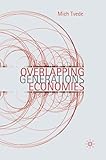Overlapping generations economies/ Tvede,Mich
Material type: TextPublication details: Uk: Palgrave macmillan, 2010Edition: 1st.edDescription: 234ISBN: 9780230243330DDC classification: 330
TextPublication details: Uk: Palgrave macmillan, 2010Edition: 1st.edDescription: 234ISBN: 9780230243330DDC classification: 330 | Item type | Current library | Call number | Status | Date due | Barcode | Item holds |
|---|---|---|---|---|---|---|
|
|
Central Library, Sikkim University General Book Section | 330 TVE/O (Browse shelf(Opens below)) | Available | P31744 |
Browsing Central Library, Sikkim University shelves, Shelving location: General Book Section Close shelf browser (Hides shelf browser)
Cover; Contents; Preface; Introduction; Part I: Overlapping Generations Economies; Chapter 1: Pure Exchange OG Economies; 1.1 Structure and Assumptions; 1.2 Expectations; 1.3 Demand; 1.4 Equilibria; 1.5 Forward Markets; 1.6 Exercises; Chapter 2: Optimality; 2.1 Allocations and Reallocations; 2.2 Improving Reallocations and Their Properties; 2.3 Notions of Pareto Optimality; 2.4 The Welfare Theorems; 2.5 Optimality of Allocations; 2.6 Parametric Reduced Models; 2.7 Optimality of Equilibrium Allocations; 2.8 Exercises; Chapter 3: Optimal Growth Economies; 3.1 Structure and Assumptions. 3.2 Forward Markets3.3 Optimality; 3.4 Spot Markets and Debt Constraints; 3.5 Comparison with OG Economies; 3.6 Exercises; Chapter 4: Stationary OG Economies; 4.1 Assumptions; 4.2 Equilibria; 4.3 Optimality; 4.4 Steady States; 4.5 On the Set of Equilibria; 4.6 Strongly Pareto Optimal Allocations; 4.7 Stationary Optimal Growth Economies; 4.8 Exercises; Chapter 5: Fluctuations; 5.1 Two-Cycles; 5.2 n-Cycles; 5.3 Sunspot Equilibria; 5.4 Endowment Vectors and Fluctuations; 5.5 Optimal Growth Economies; 5.6 Exercises; Chapter 6: Currencies; 6.1 Structure and Assumptions; 6.2 Consumers. 6.3 Equilibria6.4 On the Set of Equilibria; 6.5 Exercises; Chapter 7: OG Economies with Production; 7.1 Structure and Assumptions; 7.2 Demand, Supply and Equilibrium; 7.3 Allocations and Reallocations; 7.4 Optimality; 7.5 Steady States; 7.6 Fluctuations; 7.7 Optimal Growth Economies; 7.8 Exercises; Chapter 8: Endogenous Growth; 8.1 Structure and Assumptions; 8.2 Constant Returns to Scale; 8.3 Externalities; 8.4 Knowledge and Human Capital; 8.5 Endogenous Growth and Optimality; 8.6 Exercises; Part II: Consumers and Firms; Chapter 9: Consumers; 9.1 Assumptions and Their Implications. 9.2 Utility Maximization9.3 Demand: Price and Income; 9.4 Demand: Relative Price and Endowment; 9.5 Many Goods; 9.6 Exercises; Chapter 10: Preferred Sets and Support Functions; 10.1 Preferred Sets; 10.2 Support Functions; 10.3 Exercises; Chapter 11: Consumers under Uncertainty; 11.1 Assumptions and Their Implications; 11.2 Utility Maximization; 11.3 Demand: Price and Income; 11.4 Demand: Relative Price and Endowment; 11.5 Exercises; Chapter 12: Firms; 12.1 Assumptions and Their Implications; 12.2 Profit Maximization; 12.3 Supply; 12.4 Exercises; Appendices. Appendix A: Sequences, Sets and Functions Appendix B: Differentiability of Functions; Appendix C: Separation of Convex Sets; Appendix D: Dynamical Systems; References; Index; A; B; C; D; E; F; H; I; K; M; N; O; P; R; S; T; W.







There are no comments on this title.